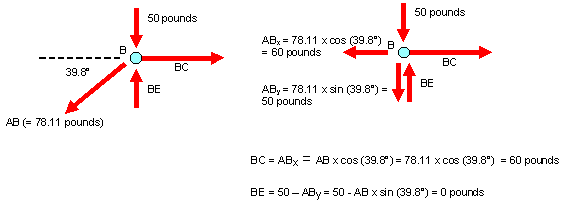|

Now that we have the
external forces calculated, we can balance the internal forces. There
are two methods that we can use for this: the
method of sections and
the method of joints. We’ll use the method of joints which analyzes
bridge forces joint by joint across the structure. A limitation of the
approach is that we must work from joints that have at most 2 unknown
forces. In this bridge, A and D are the only joints like this. Here
you see, for example, A has a force of 50 pounds pushing up in this
direction and has two unknown forces: the force AB and the force AE.
Since the bridge is symmetrical, we have the same situation occurring
on the other side of the bridge. In order to do the calculation we are
going to isolate joint A and figure out what AB and AE's forces are by
doing vector analysis.
Joint "A"

Here we've isolated joint A. We're showing the force AB coming down
the diagonal which will wind up compressing the member in the
direction of the AB arrow. AE is the tension member that pulls
the joint in the direction of the AE arrow. Because the bridge isn't
moving, we know that there is 0 pounds of force in the direction of
the Ax arrow. Because of the weight of 50 pounds coming in the
corner, we know that there's 50 pounds of force pushing the bridge
in the Ay direction. We now can take this diagram and decompose it into
its X and Y components.
The force acting
down on joint "A" is AB x sin(39.8 degrees). 39.8 degrees is the angle
at corner "A". The tension force in the X
direction has two components: The first is ABx which is pushing to the left.
Its magnitude is AB x cos(39.8 degrees) The second is AE which has an unknown
magnitude in
the direction of the arrow. But AB x sin(39.8 degrees) equals 50 pounds (that’s the force pushing down on the corner
support), so AB x sin(39.8 degrees) = 50 pounds. Solving for AB, we
know AB (the force in that diagonal direction) is equal to 50 pounds divided
by sin (39.8 degrees) which is equal to 78.11 pounds. Similarly, we know
that the force on AE has to equal the force going in the other
direction. So AE is equal to AB x cos(39.8 degrees) which is equal to
78.11 x the cos(39.8 degrees) which is equal to 60 pounds.
We’ve now fully solved the forces of corner A. we can now go to corner B and solve for the forces there.
Joint "B"

Here, we're looking at joint B. We've taken the 78.11 pounds that we
know is the component of force in the AB direction and put it on this
diagram. We’ve taken the 50 pounds of weight coming down onto point B
and shown it at the top. We now need to figure out how much force BE
exerts up and how much compression there is across BC. We're
going to do this the same way we did before, by resolving these forces
in terms of their X and Y components.
In the vector diagram's X
direction, since the bridge is not moving, ABx must equal BC.
But ABx is equal to
AB x cosine(39.8 degrees) which is equal to 78.11 x cos(39.8 degrees) which is equal to 60 pounds of force. Therefore, we
have a 60 pound force component in the BC direction.
In the vector diagram's Y
direction, we have 50 pounds coming down from the top, 50
pounds of force being transmitted down ABy, and BE's force pushing up.
This lets us solve
for BE. BE is equal to 50 pounds minus the ABy component which is 50
- AB x sin(39.8 degrees) which winds up being 50 – 50 or 0
pounds. In other words, the 50 pounds of force going in the Y
direction is transmitted completely down the diagonal and is not
supported by the "Vertical Hip" at all. So BE is 0.
Joint "E"
We can now solve for the forces on joint E. Recall that there were 0
pounds of force on point E and 60 pounds of tension on cord AE. If
there are 0 pounds coming on E and 60 pounds coming across AE that
means that the 60 pounds of tension has to be transmitted all the way
across.
By symmetry, we get
exactly the same results for the other side. The complete
Free Body Diagram is shown below.

Summary
In summary, we've figured out
if you have:
then you get:
-
"End Posts" AB, CD transmit
78.11 pounds of compressive force.
-
"Bottom Chord" AD transmits 60
pounds of tensile force.
-
"Vertical Hip" BE
(surprisingly) transmits 0 pounds of force.
-
"Top Chord" BC transmits 60 pounds of compressive
force.
In our
next
section, we'll show you how to use these particular force
calculations to better understand the materials one should use use
in constructing this bridge.
|